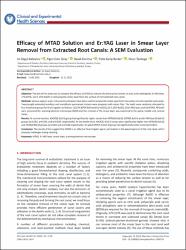Efficacy of MTAD Solution and Er:YAG Laser in Smear Layer Removal from Extracted Root Canals: A SEM Evaluation
Citation
Kalyoncu, I., Giray F. E., Durmuş, B., Berker Y. G., Tanboğa, İ. (2021). Efficacy of MTAD Solution and Er:YAG Laser in Smear Layer Removal from Extracted Root Canals: A SEM Evaluation. Clinical and Experimental Health Sciences, 11(1), 9 - 13. DOI: http://doi.org/10.33808/clinexphealthsci.794726Abstract
Abstract:Objective: The aim of this study was to compare the efficacy of MTAD (a mixture of a tetracycline isomer, an acid, and a detergent), Er:YAG laser, 17% EDTA, and 5.25% NaOCl in removing the smear layer from the surface of instrumented root canals. Methods: Various organic acids, instruments and lasers have been used to remove the smear layer from the surface of instrumented root canals. Twenty-eight extracted maxillary and mandibular permanent incisors were prepared with rotary files. The teeth were randomly allocated to four treatment groups for final irrigation as follows: (1) 17% EDTA (followed by NaOCl), (2) 5.25% NaOCl, (3) Er:YAG laser, and (4) MTAD. All teeth were processed for scanning electron microscopy (SEM) and the removal of the smear layer was examined in the apical, middle and coronal thirds. Results: At coronal location, NaOCl(2.2±0.4) group had significantly higher scores than MTAD(0.0±0.0), EDTA(0.6±0.4) and Er:YAG laser(0.6±0.4) groups (p<0.001, p=0.039, and p=0.039, respectively). At the middle third, NaOCl(2.6±0.5) scores were significantly higher than MTAD(0.0±0.0) and EDTA(0.8±0.4) groups (p<0.001 and p=0.036 respectively). At apical MTAD (0.4±0.3) group had significantly better scores (p<0.001). Conclusion: The results of this suggest that MTAD is an effective final irrigator agent, particularly in the apical segment of the root canal, which presents challenges during cleaning.


















